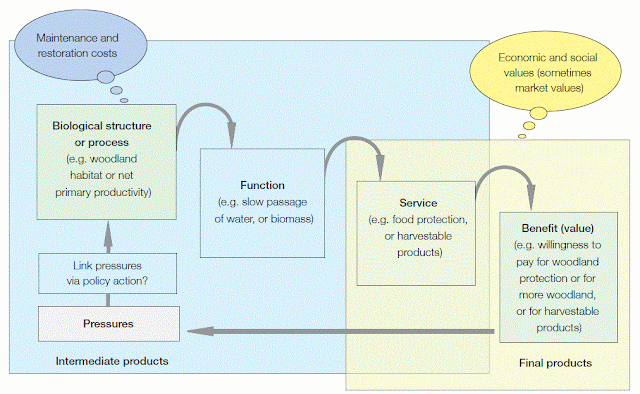Source: Roy Haines-Young, presented by J-L Weber, the Global Loss of Biological Diversity, 5-6 March 2008, Brussels
(From the TEEB Report 2010)
Welcome back to my series of blogs on Planetary boundaries, (as
defined by scientists at the Stockholm
Resilience Centre) and specifically the 3 boundaries the scientists believe
we have already breached. Last time I
looked at Climate Change; this time I’m covering Biodiversity and Nitrogen and
Phosphorous inputs to the biosphere and oceans
Biological diversity. What is biodiversity? Biodiversity is the
degree of variation of life forms within a given species, ecosystem, biome, or
an entire planet. Biodiversity is a measure of the health of ecosystems. Changes in biodiversity due to human
activity have been more rapid in the last 50 years than at any time in human
history. The drivers for change are
either steady, show no signs of declining or are increasing. These large rates of extinction can be slowed
by enhancement of habitats and maintaining high agricultural productivity (see “Land
use change” in my next blog)
Historically, the main business risk of declining
biodiversity and ecosystem services has been to corporate reputations. In
recent years, food producers and retailers in particular have been targeted
over the damage to ecosystems of their sourcing of certain products or raw
materials, such as fish and timber. However,
as global ecosystems show increasing signs of breakdown and stress, more
companies are realising how dependent their operations are on the critical
services these ecosystems provide. The decline in biodiversity and ecosystems
is making natural resources scarcer, more expensive and less diverse –
increasing the costs of water and escalating the damage caused by invasive
species to sectors including agriculture, fishing, food and beverages,
pharmaceuticals and tourism.
Continued degradation of global biodiversity and ecosystem
services could increase the pressure on these and other industry sectors. It
would add to operational risk and, in certain locations, potentially jeopardise
the long-term profitability and survival of some of the most-affected sectors such
as forest products, agriculture and fisheries. Companies further up the supply
chain or that operate “upstream” may be more susceptible to operational and
regulatory challenges, while companies down the supply chain often have a
greater degree of public exposure and therefore to potential reputational risks
The
KPMG
Report mentioned in my last blog refers to the UN initiative, “The Economics of
Ecosystems and Biodiversity” (TEEB), which estimates that the value of avoided
greenhouse gas emissions from conserving forests is US$3.7 trillion, while
insect pollinators contribute US$190 billion a year to agricultural output.
While agriculture could drive an increase in deforestation, due to
increasing demand for food, industries that depend on biodiversity for
innovation, such as pharmaceuticals, could suffer from continued primary forest
loss and have an incentive to prevent it.
Nitrogen &
Phosphorous – human impact on the nitrogen cycles has been even greater
than on the carbon cycle. It takes 5% of
the total annual global energy production, for companies to create the nitrogen
needed for the world’s food production. A small proportion of the fertilizers
applied to food production systems is taken up by plants, but 85% is wasted and
never absorbed, directly contributing to the greenhouse gas effect. It also leeches into the soil, polluting
waterways and coastal zones.
Fertilizer manufacturing companies use a strip mining
process to mine non-renewable bulk raw phosphate. Then using volatile and
harmful chemicals and acids (sulphuric acid), they transform the bulk mined
material into phosphorous which is then used in fertilizers..
If an excess of phosphate enters the waterway, algae and
aquatic plants will grow wildly, choke up the waterway and use up large amounts
of oxygen. This rapid growth of aquatic
vegetation eventually dies and as it decays it uses up oxygen. This process in
turn causes the death of aquatic life because of the lowering of dissolved
oxygen levels.
A significant fraction of the applied nitrogen and
phosphorous makes it way to the sea and can push marine systems across
thresholds of their own.
As mentioned by Sustainable
Agritech, the vital roles nitrogen and phosphorous play regarding plant
development is understood. Without them,
the people of the world today would quite literally starve to death. They feel
that by strengthening “best management practices” and incorporating Sea-Crop - a
natural source balanced formula from ocean water that has all the natural
elements known to man and which helps develop healthy and energetic plants - our
food supply would be more nutrient dense.
This will allow the world’s population to have more mineral and vitamin
rich fruits, vegetables and in some cases meats to help them to remain healthy
and more resistant to disease.
Next time I’ll be looking at those boundaries which the
Scientists at the Stockholm Resilience Centre believe we haven’t yet breached,
or the boundary is as yet unknown.






